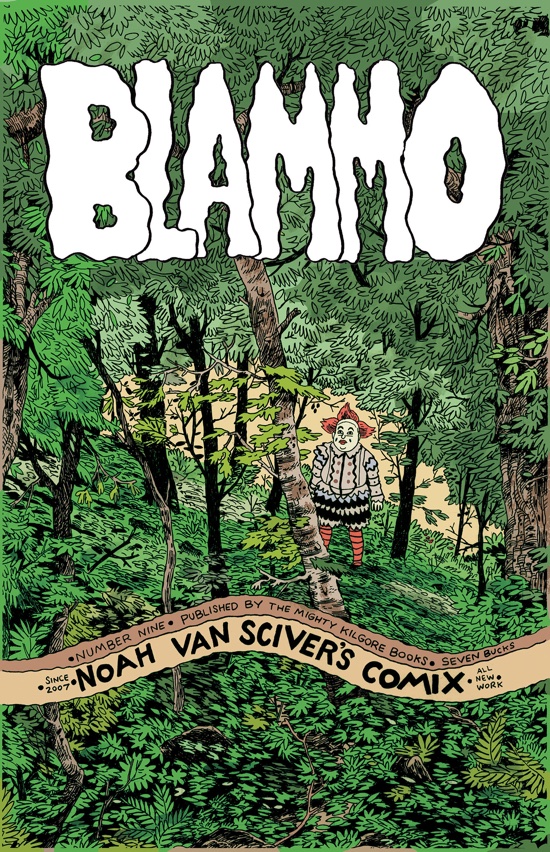A shorter month brings a shorter column but there are no disappointments to be found in the selection below.
Steven Tillotson- Untitled Ape’s Epic Adventure
(Avery Hill)
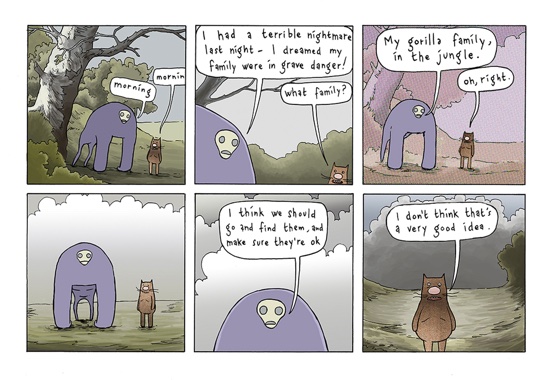
Steven Tillotson’s Untitled Ape’s Epic Adventure is a wide book, an excellent decision when your protagonist has such huge arms. Untitled Ape is, according to the blurb on the back, a giant purple ghost-beast. The ape connection, his former name and his employment history are revealed as his epic adventure unfolds. In the prologue, which follows an untitled section that might be the pre-prologue, Untitled Ape meets Cat, who has dropped his fags in a tree trunk. One display of ape-like strength later, Cat has his fags and Untitled Ape has a new travelling companion.
Tillotson makes good on his promise to provide an epic adventure. Untitled Ape wants to return to the jungle to visit his family, but his navigation skills are less good than his fag packet rescuing ability. Interesting locations follow. This is an extremely funny book, with an array of great characters. I particularly liked Garry the narwhal, initially identified as a sea unicorn, and his relationship with his wife. Animal misidentification is a running gag, with Cat never recognised as a feline. Untitled Ape’s past pops up repeatedly, and it’s not a happy one; if I ever go to hell, I hope it’s not one designed by Tillotson.
If you are looking for something that puts a smile on your face as you read it, this is an excellent choice. It would also make a great cartoon, if Avery Hill ever decided to branch out. Untitled Ape’s Epic Adventure is a joyous book, brilliant right through to the epilogue, and is a must-buy. Pete Redrup
Noah Van Sciver – Blammo #9
(Kilgore Books)
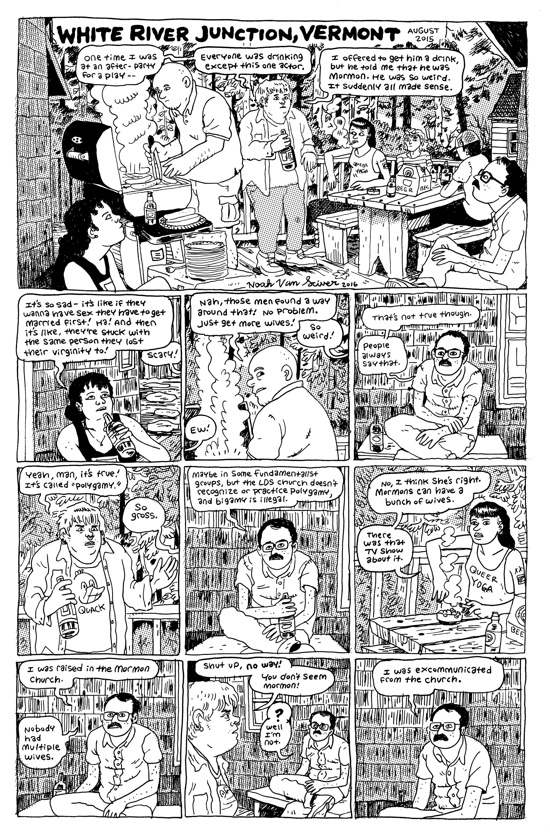
The word on Noah Van Sciver is that he has developed enormously as a cartoonist – you can hear this from his peers, publishers and critics. So what does this look like? Well, it looks like Blammo 9’s blend of autobiography and fiction, and in particular, the masterful White River Junction, Vermont.
A mixture of events, past and present, it’s full of inner monologues as Van Sciver goes about his day, taking a walk in the countryside, looking at graves, and generally enjoying nature. The range packed into this is considerable, but it’s just so well put together that it is totally cohesive. One strand has him reflecting on his time at CCS, and the culture shock he experiences there. He is utterly baffled by the concepts of safe spaces and triggering that appear to be common parlance among the students, which arises as a result of their presumptions about his Mormon upbringing. He presents this in a way that is funny, yet not mean, as he is accused by the administration of ’negativity towards manga readers and expressive clothing’.
One bonus with Van Sciver is that you get particularly good value for money – this may be a single issue, but the panel density and text size means that there’s more content here than many cartoonists put into a book with twice as many pages. He’s just so prolific, and there’s no filler at all. As is customary, his fictional characters aren’t losers, but Van Sciver doesn’t tend to write about the wealthy elite and what luxury car they’ve just bought, or where they plan to holiday next. He tends to write fiction about people who are struggling in (at least) one way or another.
This is an essential purchase – if you’re a fan, you need it, and if you’ve not read Van Sciver before, this is the perfect place to start. Pete Redrup
Simon Moreton – What Happened
(Kilgore Books)
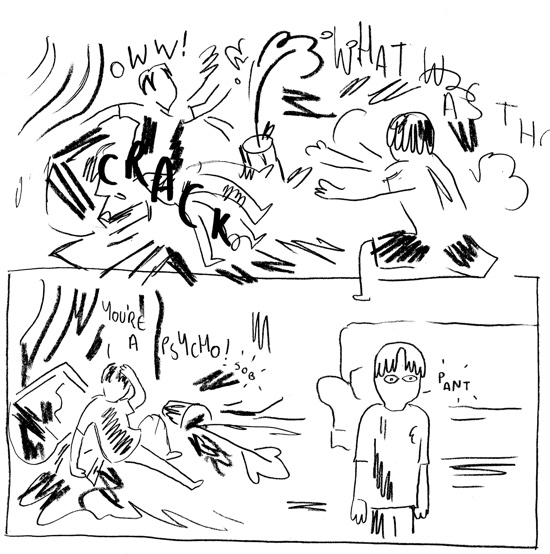
It’s almost as if Simon Moreton is on a mission to release one book with a carefully selected list of some of the finest indie comics publishers around. Following titles from Avery Hill and Uncivilized, this time it’s Kilgore Books’ turn. It’s an interesting strategy – with each imprint having different reaches, his work becomes available to an increasing spectrum of readers, who may then discover that he also self-publishes plenty as well. It also raises the question of who will bring out the next one.
Despite experimentation with a dot shading technique, What Happened is instantly recognisable as Moreton’s work. The resignation of John Major tells us that the comic is set in 1997, depicting a series of events over the course of that summer. We get that particular evocation of adolescence that Moreton does so convincingly, showing a real gift for conveying the texture of different times in life with often ambiguous imagery and little in the way of words.
One sequence shows the protagonist at a friend’s house where his host has a fight with his brother and breaks the TV. The way he just runs wordlessly out of the house is very funny, and is of course exactly what most people that age would do after witnessing a massively awkward situation like that. It’s depicted with great kinetic energy; an eight panel two page spread losing the borders on the second half as arguing turns to fighting, before moving to wider images to show the aftermath and destruction.
Looking back on a similar time of his life to Plans We Made, What Happened is another charming, reflective work that is deceptively simple, repaying your careful attention. Pete Redrup
Robert Hunter – Map of Days
(Nobrow)
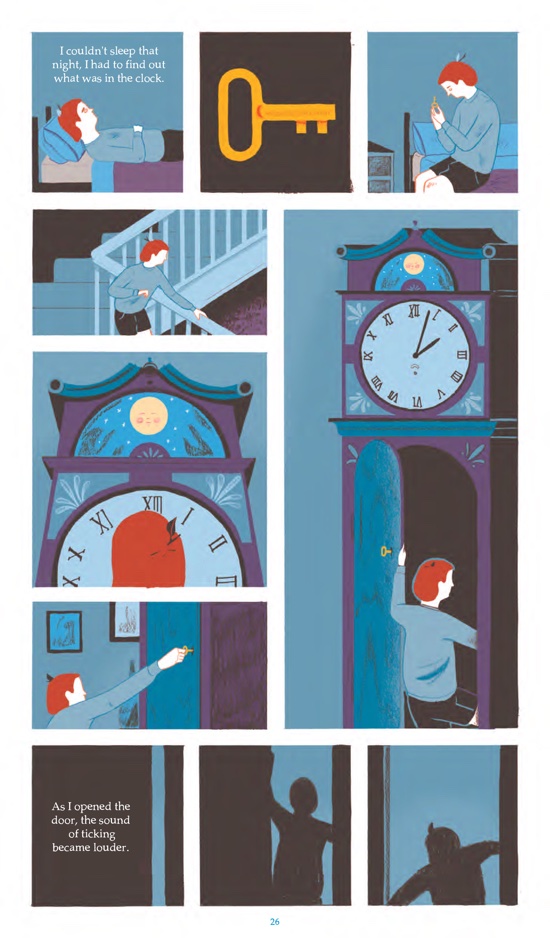
Nobrow has seen fit to produce a lovely hardback reissue of Robert Hunter’s Map Of Days, and who am I to disagree? Having not read it back in 2013, I looked on a certain online retailer’s website for second hand copies of the original. They range from the eye-wateringly expensive to the you-could-buy-this-book-or-you-could-buy-two-laptops price point, so this starts to look much like an act of public service.
From the outside, it looks very Nobrow. Inside, it is full of beautiful 4 colour spot printed artwork, something for which I have become a sucker over the years. The story begins with a poetic introduction about the formation of our solar system and then we meet Richard, a teenager visiting his grandfather. Grandfather Frank has a house full of mysterious and interesting objects, and has a particular passion for grandfather clocks, which he carefully synchronises each day with a special key. One day Richard’s curiosity leads him to explore the interior of one of these clocks, and he discovers many unexpected things which I have no intention of spoiling.
Map Of Days presents a captivating and unique world, where we find an utterly original tale. It has exactly the sort of artwork that looks so great when printed like this, and reminded me a little of Michael DeForge’s ability to create a strange and fantastic take on our lives. It is a very fine book, and a bargain at the retail price. Pete Redrup
Joe Ollmann – The Abominable Mr Seabrook
(Drawn & Quarterly)
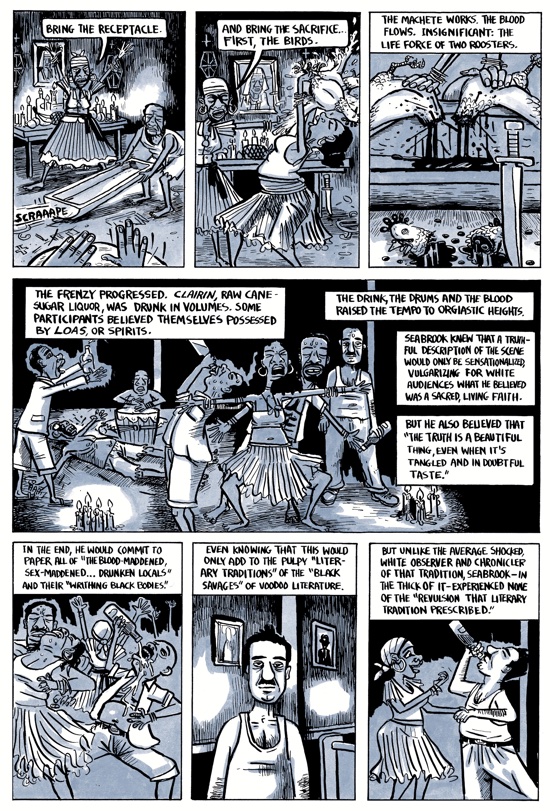
Perhaps best known as the person who popularised the word zombie in the English-speaking world, William Seabrook makes a much better subject for a biography than he made a spouse. His considerable vices included alcoholism and sadism, and as a famous explorer and travel writer he lived a genuinely remarkable life.
His early career involved numerous successful jobs which he then abandoned. Drifting into journalism, he soon found his work was more effective when he actively participated in the subject, such as when he parachuted out of a hot air balloon whilst covering the county fair. Joe Ollmann’s book charts his rise and seemingly inevitable fall over many years, a considerable number of books, and unimaginable quantities of alcohol. His bestsellers included accounts of his time with bedouins and gaining access to the secretive world of voodoo in Haiti. Success brought money, money brought the opportunity to indulge his vices more spectacularly, and so he drank more while writing less. When it was revealed that his account of cannibalism was falsified, and that the meat he had eaten was actually from a non-human primate, his popularity diminished and marked a decline in his fortunes. Ironically, he had actually rectified the omission by buying human flesh from a morgue attendant and having a chef prepare it three ways, but this wasn’t known at the time. I’m still not sure which is more shocking, the unsuccessful attempt to eat human flesh in the jungle or the subsequent failure rectification strategy.
Ollman brings a rakish, dishevelled presentation of Seabrook which works brilliantly. The black and grey-blue palette is particularly effective at conveying the fact that despite countless exotic locations, his demons always travelled with him. He includes comparisons of Seabrook’s own accounts of his life with those of his contemporaries, from his second wife Marjorie to Aleister Crowley and Man Ray. Ollmann has produced a substantial, fascinating portrait of a deeply unsympathetic but nonetheless entertaining man, a book well worth reading. Pete Redrup
Kickliy – Musnet 1 & 2
(Odod)
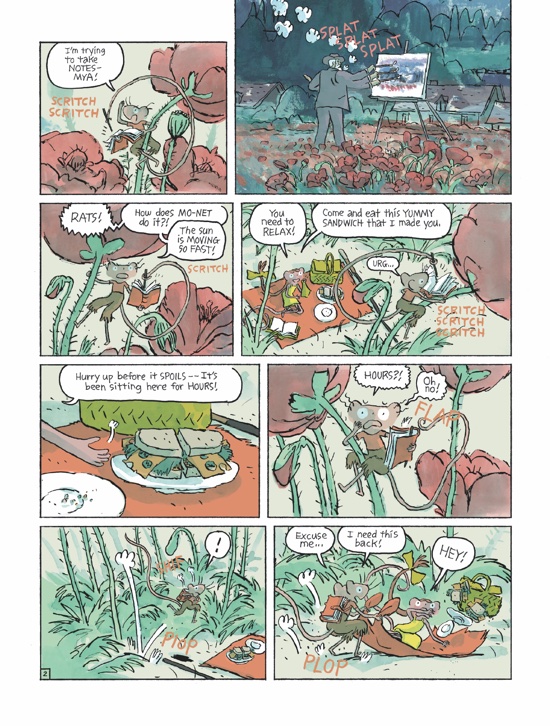
Odod is Uncivilized’s new imprint for children’s books, up and running as a result of a succesful Kickstarter campaign. The first releases include two Musnet books, with another pair to follow. Set in nineteenth century France, they follow Musnet (a mouse) who wants to become a painter, and finds himself a job as an artist’s assistant, working for a irascible squirrel called Rémi. His employment is the result of meeting Mya, another mouse, and before too long her family invite Musnet to live in their spare room. The human occupant of their huge house turns out to be Monet, and once this is established the stage is set.
As well as the typical struggles and adventures one expects for this audience, the book also provides art education by stealth, and insight into the struggles faced by artists. The first book, The Mouse Of Monet, introduces the characters and settings, and sees Musnet find his job and ask to be paid in art lessons. His tutor Rémi is definitely of the Mr Miyagi school of teaching, so we learn about making canvasses and mixing paints rather than watching a mouse paint masterpieces. The second book, Impressions Of The Master, continues in a similar vein but with a little more adventure now the setup has been established.
Both titles feature the same beautiful painted artwork, alongside charming and good natured storytelling which finds time for adventures, heroism and lessons on social values alongside the art school. There are delightful touches such as glimpses of famous Monet locations in the garden and although aimed at a younger audience, there’s much for all ages to enjoy here. These are lovely books that work on every level, definitely worth looking out for. Pete Redrup
Benoit Peeters & Francois Schuiten – The Theory of the Grain of Sand
(IDW Publishing)
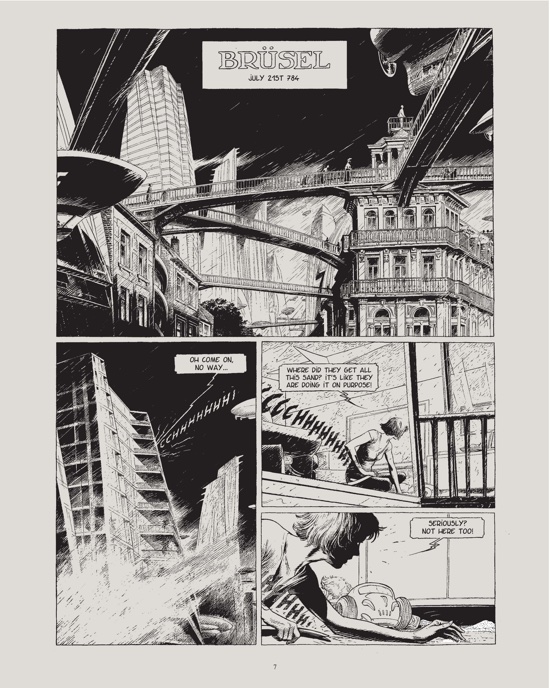
In my opinion The Obscure Cities is one of the most important works of comic literature, and has long been in need of a wider release. The series has had a bumpy publishing history in English, beginning with Heavy Metal in the 80s, continuing with Dark Horse in the 90s, and followed by NBM’s sporadic printing of titles into the early 2000s. After NBM the series seemed poised for total anonymity until translator Stephen D. Smith published The Leaning Girl, and now partnered with IDW The Obscure Cities may have finally found a permanent home.
The Theory of the Grain of Sand is one of the final books in the series, but that does not limit its readability since every book is a self-contained story with only minor references to other characters and/or places. What links the books in this series isn’t an overarching plot, but an exploration of architecture and its influence on our psychology through enigmatic events and occurrences. A few of the enigmas to be found in The Theory of the Grain of Sand include a woman’s apartment perpetually filling with an endless supply of sand, a man’s discovery of duplicating stones, and a cook that becomes weightless regardless of what he eats; all of which are connected by the death of an exotic stranger in the city of Brüsel.
Peeters’ stories are like nothing else in comics, but the series’ real claim to fame is Schuiten’s astonishing artwork. Every panel has the detail of a Franklin Booth or Gustave Dore illustration, and it is no surprise that Schuiten comes from a family of architects and lives in the real world counterpart of Brüsel – Brussels, a city famous for its clashing classical and modern designs. In this book especially old and new are constantly at odds with each other in a world that is clearly in disharmony with itself, an idea cleverly reflected by the glaring white highlights protruding from the grey toned paper.
I envy anyone getting to experience the work of Peeters and Schuiten for the first time, and The Theory of the Grain of Sand is a great place to start. However, if you’re a person that needs to read a series in order then you won’t have long to wait since IDW’s next title in The Obscure Cities lineup is a new and expanded edition of the first book, The Great Walls of Samaris. Matthew Laiosa
Pierre Wazem & Aubin – Snow Day
(Humanoids)
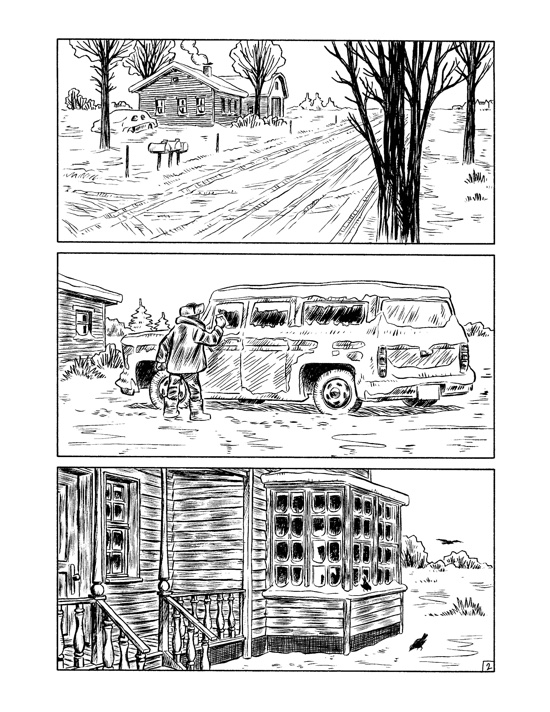
It shouldn’t come to any surprise that a Swiss writer is responsible for such a well-crafted rural American crime story considering that Italians directed many of the best Westerns. Snow Day continues to prove that stories don’t have borders, and a good book can be written by anyone regardless of their origins. It helps that Pierre Wazem has already proven himself as one of the leading comic writers from Europe with his Miyazaki-inspired masterpiece, Koma, but it takes more than good storytelling to separate oneself from the rest of the crowd; it takes Wazem’s distinctive mastery of the silent moment. Wazem leaves out as much as he puts in, and trusts his artistic collaborators to build atmosphere and character through the power of images. Without tallying the book panel for panel my guess is that nearly half of the story is told wordlessly, which perfectly captures the quiet solitude of a fresh snowfall.
After a series of cinematic vignettes Snow Day begins with a frustrated factory owner, Ross, face to face with a diminutive sheriff, Spencer, in a town seemingly without moral. Spencer refuses to release three of Ross’ workers, which Ross uses to bust up discontented and organizing labourers. With Spencer’s refusal Ross fetches the mayor for support, leading to the forced release of the inmates. Spencer then must decide whether it’s worth it to follow his principles and re-arrest Ross’ thugs at the factory or turn a blind eye.
Part of what makes this book so effective is the environment where it takes place. Snow is an ideal setting since it provides an abundance of negative space, which accentuates the isolation and dilemma of Spencer’s ethical stance. Of course, none of this could be conveyed without Aubin’s versatile line art able to perfectly capture the mood of every scene. The majority of the work reminds me of Chinese calligraphy painting with its dynamic energy and contrasting Zen-like silence, but when needed Aubin’s art can be scratchy to signify a drunken flashback, or clumsy and aggressive to express the oppressiveness of the factory’s steaming pipes. The shifts in style engross the reader in Spencer’s psyche while capturing a feeling of authentic frigidness, making Snow Day a surprisingly immersive read despite its apparent simplicity. It has been a long time since I’ve read anything new from Humanoids, but given the quality of Snow Day I’ll definitely be returning to an old favorite. Matthew Laiosa

